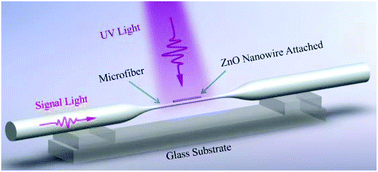A ZnO nanowire-based microfiber coupler for all-optical photodetection applications
Abstract
The temporal response of conventional ZnO nanowire-based photodetectors suffers from the influence of carrier mobility and high electrical resistance. As a result, these devices can be prohibitively slow for some applications, generally with a response time on the order of 1 second. This study presents a novel ZnO nanowire-based microfiber coupler structure for all-optical photodetection without the demand for photocurrent generation. In this design, two waveguides are directly adsorbed by van der Waals forces or electrostatic forces. Compared with the conventional electrical bridge structure, the optical coupling architecture makes the device both compact and stable. In this configuration, resonance dips form in the transmission spectrum when the phase-matching conditions of the two waveguides are satisfied. The measurements of the resulting wavelength shift, low noise levels, and repetition time confirmed that the proposed optical device could operate as a photodetector. The device exhibits superior performance with a sensitivity of 1.657 nm (W cm−2)−1 and a response time of 0.43 ms. In addition, the detector features a simple fabrication as there is no need for extra modification of ZnO nanowires. The resulting photodetection capabilities could provide a new functionality for novel all-optical applications.



 Please wait while we load your content...
Please wait while we load your content...